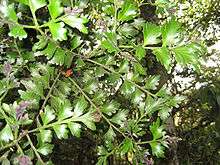Phyllocladus trichomanoides
Phyllocladus trichomanoides, the tanekaha or celery pine, is a coniferous tree endemic to New Zealand.
| Tanekaha | |
|---|---|
 | |
| Scientific classification | |
| Kingdom: | Plantae |
| Clade: | Tracheophytes |
| Division: | Pinophyta |
| Class: | Pinopsida |
| Order: | Pinales |
| Family: | Podocarpaceae |
| Genus: | Phyllocladus |
| Species: | P. trichomanoides |
| Binomial name | |
| Phyllocladus trichomanoides D.Don | |
Description
Tanekaha is a medium-sized forest tree growing up to 25 m in height and 1 m trunk diameter.[2] The main structural shoots are green for 2–3 years, then turn brown as the bark thickens. The leaves are sparse, tiny, scale-like, 2–3 mm long, and only green (photosynthetic) for a short time, soon turning brown.
Most photosynthesis is performed by highly modified, leaf-like short shoots called phylloclades; these are arranged alternately, 10-15 on a shoot, the individual phylloclades rhombic, 1.5-2.5 cm long. The seed cones are berry-like, with a fleshy white aril surrounding but not fully enclosing the single seed.
Distribution
In the North Island this species is found in lowland forests from Te Paki to 40°S.[2] In the South Island this species is found in northern Marlborough and Nelson to 41°30'S.[2]
Economic uses
Like the kauri, tanekaha shed their lower branches, producing smooth straight trunks and knot-free timber which is sought after for its strength.
The bark is rich in tannin, from which Māori extracted a red dye.
References
- IUCN (2011-01-28). "Phyllocladus trichomanoides: Farjon, A.: The IUCN Red List of Threatened Species 2013: e.T42269A2968482". doi:10.2305/IUCN.UK.2013-1.RLTS.T42269A2968482 (inactive 2020-01-22). Cite journal requires
|journal=(help) - Eagle, Audrey (2008). Eagle's complete trees and shrubs of New Zealand volume one. Wellington: Te Papa Press. p. 32. ISBN 9780909010089.
External links
| Wikimedia Commons has media related to Phyllocladus trichomanoides. |
